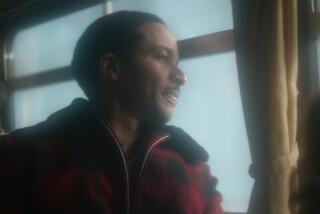Not a resurrection
- Share via
Every year, the ranks of Oscar nominees are filled with actors who spend months perfecting their accents and practicing their gestures to deliver note-perfect interpretations of historical figures, and their efforts tend to pay off. Seven of the last eight top acting awards have gone to actors doing their best to raise the dead.
On paper, Paul Schneider’s turn as Charles Armitage Brown in Jane Campion’s “Bright Star” fits the criteria nicely. The story, which centers on the romantic poet John Keats, his friend and patron Brown, and Keats’ lover, Fanny Brawne, is drawn from history, and Schneider transformed his body to fit the part, gaining a substantial potbelly, growing a thick beard and adopting a light Scottish brogue. But unlike two-time Oscar winner Hilary Swank, who took flying lessons to prepare for her role as Amelia Earhart, Schneider was not overly concerned with emulating the real Charles Brown.
“I didn’t even attempt it,” he said just before the film hit the Telluride/Toronto circuit that begins the long march to Oscar night. “We don’t know what he was like, so it’s a moving target. If I set myself out a job to say I want to be just like Charles Brown, then it’s a snipe hunt.”
Schneider’s decision was partly practical; even Brown’s biography, “The Friend of Keats,” is more concerned with his relationship to the poet than with Brown himself. But it also stems from his conviction that an overreliance on mimicry can detract from a performance, no matter what the academy may think.
“I think it’s a serious mistake when people set out to impersonate other people in film. I think the ability to do it is almost like a crazy carnival trick. But I don’t want to see Jim Carrey doing Andy Kaufman, because I saw video of Andy Kaufman. It’s pretty close, but you’re setting yourself up a goal that’s impossible. I was far more drawn to what Christopher Plummer did in ‘The Insider,’ where he didn’t try to act like Mike Wallace, but he affected Mike Wallace.”
Schneider, who favors eccentric projects like the blow-up doll fable “Lars and the Real Girl” or the lyrical western “The Assassination of Jesse James by the Coward Robert Ford,” thinks of himself as an industry outsider, despite his current gig on the NBC sitcom “Parks and Recreation.” Where most actors would relish the attention he’s been getting since the film’s premiere at Cannes, Schneider seems genuinely uncomfortable being singled out for praise.
“A lot of whatever [I did that] was good about Charles Brown was good because I had really great co-workers that you feel safe around, safe to try things, safe to do stuff without looking like a moron. I don’t mean to totally tamp down my own involvement. I was there. I did it. [But] I feel like I need people around that I like, that like me, that we create these things together.”
That sense of safety laid the groundwork for Schneider to expand outside his comfort zone, beyond the easygoing rogues he often plays. The scene in which Brown comes to terms with his failure to protect Keats from his own worst impulses is more intensely dramatic than anything he has done on screen before. Schneider’s initial impulse was to play down the character’s desperation, especially given the presence of Abbie Cornish’s Fanny, his bitter rival for Keats’ attention.
“I certainly didn’t think Brown should be crying and getting overly emotional, because you don’t cry in front of your enemies.” But after working out several approaches, Schneider decided to play the scene without making any decisions in advance, effectively acting without a net. “I thought, ‘Well, I’ll get a little more emotional and see what that feels like.’ And then I decided to stop giving myself jobs to do. Why don’t I just go in the scene and see what happens? Why am I giving myself parameters? I need to go in there and feel whatever I feel. After a while, it’s not about me trying to be Charles Brown. That far into the movie, if the movie has told the audience, ‘This is Charles Brown,’ then whatever Paul decides to do, it’s Charles Brown deciding to do it.”
--
More to Read
Only good movies
Get the Indie Focus newsletter, Mark Olsen's weekly guide to the world of cinema.
You may occasionally receive promotional content from the Los Angeles Times.







